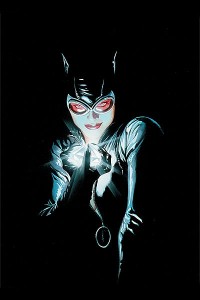In the original version of the story and the vast majority of retellings, Batman's secret identity is Bruce Wayne, an American millionaire (later billionaire) playboy, industrialist, and philanthropist. Having witnessed the murder of his parents as a child, he swore revenge on crime, an oath tempered with the greater ideal of justice. Wayne trains himself both physically and intellectually and dons a bat-themed costume in order to fight crime. Batman operates in the fictional American Gotham City, assisted by various supporting characters including his crime-fighting partner, Robin, his butler Alfred Pennyworth, the police commissioner Jim Gordon, and occasionally the heroine Batgirl. He fights an assortment of villains such as the Joker, the Penguin, the Riddler, Two-Face, Poison Ivy and Catwoman. Unlike most superheroes, he does not possess any superpowers; he makes use of intellect, detective skills, science and technology, wealth, physical prowess, martial arts skills, an indomitable will, fear, and intimidation in his continuous war on crime.
In early 1939, the success of Superman in Action Comics prompted editors at the comic book division of National Publications (the future DC Comics) to request more superheroes for its titles. In response, Bob Kane created "the Bat-Man." Collaborator Bill Finger recalled "Kane had an idea for a character called 'Batman', and he'd like me to see the drawings. I went over to Kane's, and he had drawn a character who looked very much like Superman with kind of ... reddish tights, I believe, with boots ... no gloves, no gauntlets ... with a small domino mask, swinging on a rope. He had two stiff wings that were sticking out, looking like bat wings. And under it was a big sign ... BATMAN."
Finger offered such suggestions as giving the character a cowl instead of a simple domino mask, a cape instead of wings, and gloves, and removing the red sections from the original costume. Finger said he devised the name Bruce Wayne for the character's secret identity: "Bruce Wayne's first name came from Robert Bruce, the Scottish patriot. Bruce, being a playboy, was a man of gentry. I searched for a name that would suggest colonialism. I tried Adams, Hancock ... then I thought of Mad Anthony Wayne." He later said his suggestions were influenced by Lee Falk's popular The Phantom, a syndicated newspaper comic-strip character with which Kane was familiar as well.
Various aspects of Batman's personality, character history, visual design, and equipment were inspired by contemporary popular culture of the 1930s, including movies, pulp magazines, comic strips, newspaper headlines, and even aspects of Kane himself. Kane noted especially the influence of the films The Mark of Zorro (1920) and The Bat Whispers (1930) in the creation of the iconography associated with the character, while Finger drew inspiration from literary characters Doc Savage, The Shadow, and Sherlock Holmes in his depiction of Batman as a master sleuth and scientist.
Kane signed away ownership in the character in exchange for, among other compensation, a mandatory byline on all Batman comics. This byline did not, originally say "Batman created by Bob Kane"; his name was simply written on the title page of each story. The name disappeared from the comic book in the mid-1960s, replaced by credits for each story's actual writer and artists. In the late 1970s, when Jerry Siegel and Joe Shuster began receiving a "created by" credit on the Superman titles, along with William Moulton Marston being given the byline for creating Wonder Woman, Batman stories began saying "Created by Bob Kane" in addition to the other credits.
Finger did not receive the same recognition. While he had received credit for other DC work since the 1940s, he began, in the 1960s, to receive limited acknowledgment for his Batman writing; in the letters page of Batman #169 (February 1965) for example, editor Julius Schwartz names him as the creator of the Riddler, one of Batman's recurring villains. However, Finger's contract left him only with his writing page rate and no byline. Kane wrote, "Bill was disheartened by the lack of major accomplishments in his career. He felt that he had not used his creative potential to its fullest and that success had passed him by." At the time of Finger's death in 1974, DC had not officially credited Finger as Batman co-creator.
Jerry Robinson, who also worked with Finger and Kane on the strip at this time, has criticized Kane for failing to share the credit. He recalled Finger resenting his position, stating in a 2005 interview with The Comics Journal: Although Kane initially rebutted Finger's claims at having created the character, writing in a 1965 open letter to fans that "it seemed to me that Bill Finger has given out the impression that he and not myself created the ''Batman, t' [sic] as well as Robin and all the other leading villains and characters. This statement is fraudulent and entirely untrue." Kane himself also commented on Finger's lack of credit. "The trouble with being a 'ghost' writer or artist is that you must remain rather anonymously without 'credit'. However, if one wants the 'credit', then one has to cease being a 'ghost' or follower and become a leader or innovator." The first Batman story, "The Case of the Chemical Syndicate," was published in Detective Comics #27 (May 1939). Finger said, "Batman was originally written in the style of the pulps," and this influence was evident with Batman showing little remorse over killing or maiming criminals. Batman proved a hit character, and he received his own solo title in 1940, while continuing to star in Detective Comics. By that time, National was the top-selling and most influential publisher in the industry; Batman and the company's other major hero, Superman, were the cornerstones of the company's success. The two characters were featured side-by-side as the stars of World's Finest Comics, which was originally titled World's Best Comics when it debuted in fall 1940. Creators including Jerry Robinson and Dick Sprang also worked on the strips during this period.
In early 1939, the success of Superman in Action Comics prompted editors at the comic book division of National Publications (the future DC Comics) to request more superheroes for its titles. In response, Bob Kane created "the Bat-Man." Collaborator Bill Finger recalled "Kane had an idea for a character called 'Batman', and he'd like me to see the drawings. I went over to Kane's, and he had drawn a character who looked very much like Superman with kind of ... reddish tights, I believe, with boots ... no gloves, no gauntlets ... with a small domino mask, swinging on a rope. He had two stiff wings that were sticking out, looking like bat wings. And under it was a big sign ... BATMAN."
Finger offered such suggestions as giving the character a cowl instead of a simple domino mask, a cape instead of wings, and gloves, and removing the red sections from the original costume. Finger said he devised the name Bruce Wayne for the character's secret identity: "Bruce Wayne's first name came from Robert Bruce, the Scottish patriot. Bruce, being a playboy, was a man of gentry. I searched for a name that would suggest colonialism. I tried Adams, Hancock ... then I thought of Mad Anthony Wayne." He later said his suggestions were influenced by Lee Falk's popular The Phantom, a syndicated newspaper comic-strip character with which Kane was familiar as well.
 THE DARK KNIGHT RISES CATWOMAN |  Dark Knight Rises catwoman |  Dark Knight Rises\x26#39; Posters |  Catwoman Costume Details |  The Dark Knight Rises is |
 in \x26#39;The Dark Knight Rises. |  from The Dark Knight Rises |  THE DARK KNIGHT RISES, |  Dark Knight Rises Latest: |  Anne Hathaway\x26#39;s Catwoman |
Finger did not receive the same recognition. While he had received credit for other DC work since the 1940s, he began, in the 1960s, to receive limited acknowledgment for his Batman writing; in the letters page of Batman #169 (February 1965) for example, editor Julius Schwartz names him as the creator of the Riddler, one of Batman's recurring villains. However, Finger's contract left him only with his writing page rate and no byline. Kane wrote, "Bill was disheartened by the lack of major accomplishments in his career. He felt that he had not used his creative potential to its fullest and that success had passed him by." At the time of Finger's death in 1974, DC had not officially credited Finger as Batman co-creator.
 The Dark Knight Rises, |  in \x26#39;Dark Knight Rises\x26#39; |  in The Dark Knight Rises |  DARK KNIGHT RISES: Anne |  Costume Dark Knight Rises |
 for The Dark Knight Rises |  Re: The Dark Knight Rises |  in \x26#39;Dark Knight Rises\x26#39; |  on The Dark Knight Rises |  Download 100 Love Songs |
No comments:
Post a Comment